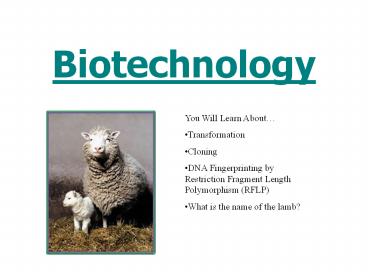Biotechnology - PowerPoint PPT Presentation
1 / 26
Title:
Biotechnology
Description:
Biotechnology You Will Learn About Transformation Cloning DNA Fingerprinting by Restriction Fragment Length Polymorphism (RFLP) What is the name of the lamb? – PowerPoint PPT presentation
Number of Views:102
Avg rating:3.0/5.0
Title: Biotechnology
1
Biotechnology
- You Will Learn About
- Transformation
- Cloning
- DNA Fingerprinting by Restriction Fragment Length
Polymorphism (RFLP) - What is the name of the lamb?
2
Brainstorm
- What are some ways in which DNA can be used as a
tool (think about TV, the news)
3
Goals of Applied Genetics
- Help humans create crops that can be frost
resistant (we love our peaches!) - Use transgenic organisms to help medical
researchers model human physiology for testing - Help industry to create bacteria to break down
pollutants into harmless products - Pharmaceutical companies use recombinant DNA to
cheaply produce human hormones (insulin) and
other proteins - Help solve crimes and determine relatives
4
Technologies Addressed in this Showplease write
these on first slide
- Bacterial Transformation
- Cloning
- DNA fingerprinting (RFLP analysis)
5
Selective breeding
- Selecting organisms with the most desirable
traits - Requires time and several generations to produce
offspring with the desired trait - Ex
- Short vs long haired cats
- Milk production in cattle
- Disease resistant foods
- Bacteria that break down oil
6
Bacterial Transformation
- Also called recombinant DNA technology or gene
cloning - Uses a bacterial host because of fast
reproduction and a circular DNA vehicle to hold
the foreign DNAplasmid - Organisms containing recombinant DNA or foreign
DNA are known as transgenic
7
(No Transcript)
8
Steps involved
- Select the desired gene(s) to be inserted into
the organism and a bacterial host containing a
plasmid (vehicle to hold the desired gene) - Cut two DNA molecules into fragments with special
(restriction) enzymes - Splice (rejoin) the fragments (gene and plasmid)
together in the desired combination - Introduce or insert the new DNA into a living
cell for replication (mitosis)
9
Vector to transfer DNA
10
Enzymes
- Restriction Enzymes Used to cut a DNA molecule at
a specific nucleotide sequence - Produces one of two types of DNA fragments
- Sticky ends (palindrome)
- Blunt ends
11
Sticky Ends (palindrome)
Blunt ends
12
(No Transcript)
13
Gene Cloning
- Used to produce genetically identical copies of a
cell, tissue, organ, and/or organism - Needed to produce multiple copies of the desired
DNA
14
Cloning Applications
- Currently
- Plants are cloned to produce a large number of
genetically identical plants in a short amount of
time - Future
- Clone productive and healthy animals to increase
yield for farmers and to grow organs for
transplants
15
How cloning works.
16
Gene Therapy
- The insertion of normal genes into human cells to
correct genetic disorders like cystic fibrosis.
(Not successful yet?)
17
DNA Fingerprinting(RFLP Analysis)
- Obtain a small sample of DNA
- Make millions of copies using PCR (polymerase
chain reaction) technique - Cleave (cut) DNA with restriction enzymes
- Separate DNA fragments using gel electrophoresis
and compare - Each humans DNA will have some unique pieces
because each of our DNA is unique
18
Gel Electrophoresis
- Gel electrophoresis is used to create a DNA
fingerprint - Small amounts of DNA are loaded into wells in the
gel. - An electric current pushes the small pieces of
DNA farther down the gel than the larger pieces. - DNA patterns are compared to known patterns
(Human Genome Project). - Used for forensics, blood samples, and paternity
tests (children get half their bands from mom and
half from dad)
19
Running a gel
20
How DNA moves
Step 1 Make wells in gel.
21
Step 2 Pipette DNA into wells.
22
Step 3 Run an electric current to watch DNA
migrate.
23
Step 4 Notice similarities and differences in
banding patterns.
24
(No Transcript)
25
The Human Genome Project
- There are approximately 25,000 genes on the 46
human chromosomes (far fewer than expected) - Human Genome Project- an international effort to
completely map and sequence human chromosomes
(completed April 2003) - This has been important in
- identifying genes that are related to disease.
- Determining human relationships with other
species.
26
Microarray
- An new technology, the microarray, allows a cell
to be samples for many genes at once. - It is involved in finding
- What genes are important in cancer and cancer
prevention. - What medicines can be used for a person
(customized medicine) - Much more, and we will spend some time with this.































